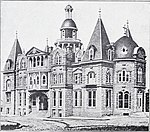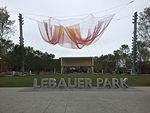North Carolina Agricultural and Technical State University (also known as North Carolina A&T State University, North Carolina A&T, N.C. A&T, or simply A&T) is a public, historically black, land-grant research university in Greensboro, North Carolina. It is a constituent institution of the University of North Carolina System. Founded by the North Carolina General Assembly on March 9, 1891, as the Agricultural and Mechanical College for the Colored Race, it was the second college established under the provisions of the Morrill Act of 1890, as well as the first for people of color in the State of North Carolina. Initially, the college offered instruction in agriculture, English, horticulture and mathematics. In 1967, the college was designated a Regional University by the North Carolina General Assembly and renamed North Carolina Agricultural and Technical State University.With an enrollment of over 13,000 students, North Carolina A&T is the largest historically black college or university (HBCU) in the United States, a position it has held since 2014. The university's College of Engineering graduates more black engineers than any other campus in the United States; its College of Agricultural and Environmental Sciences produces more African American agriculture graduates than any campus in the country. The university is also a leading producer of African-American kinesiology undergraduates, landscape architects, nurses, teachers, and journalism/mass communication graduates.
The university offers 54 undergraduate, 29 master's, and 9 doctoral degree programs through its eight colleges, one school, and one joint school; the university awards more than 2,600 degrees annually and has an alumni base of around 65,000. The main campus encompasses over 600 acres (240 hectares) in area, as well as a 492-acre (199 ha) working farm, and two research parks totaling a combined 150 acres (60 ha). It is classified among "R2: Doctoral Universities – High research activity". The university ranks third in sponsored funding among University of North Carolina System institutions. As of 2021, the university conducts over $78 million in academic and scientific research annually, and operates 20 research centers and institutes on campus. The university's designation as a land grant institution reflects its broad range of research with ongoing projects funded by agencies such as the National Aeronautics and Space Administration (NASA), U.S. Department of Agriculture, U.S. Department of Defense, National Institutes of Health and the National Science Foundation.The university's students, alumni, and sports teams are known as "Aggies". The university's varsity athletic teams are members of the Colonial Athletic Association (CAA) in all sports with the exception of women's bowling and football. As members of the Mid-Eastern Athletic Conference (MEAC), from 1970 to 2021, the football program earned 11 conference championships, made 5 NCAA FCS playoff appearances, and won the Celebration Bowl 4 times from 2015 to 2019. The men's basketball program has reached the NCAA Tournament 10 times, while the women's basketball team has made the tournament 5 times, with their most recent appearance being in 2021. The Aggies' men's and women's track and field teams, placed third and fourth respectively, at the 2021 NCAA Division I Outdoor Track and Field Championships. Members of the team went on to represent the United States at the 2020 Olympics, where they captured 3 medals, 2 of them being gold.











